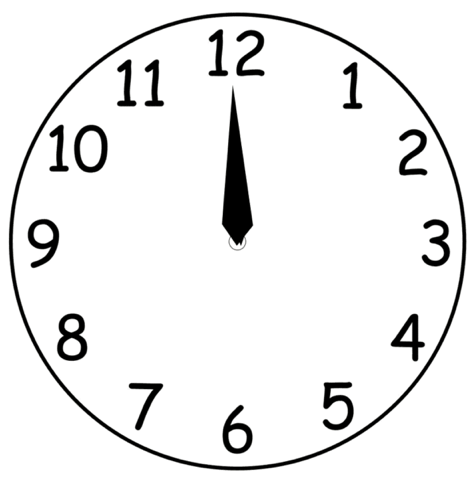To begin, think about clocks.

This one is too complicated. Try something simple.

This one says 12 o’clock. Or just 12.

The left-hand clock above says 4. You can think of this several different ways. It could be the time of day: 4:00. Or it could mean 4 hours of time. Wait for 4 hours.
Let’s think of it the second way. You can add waits together. Waiting 4 hours, plus waiting 4 hours, is like waiting for 8 hours on the clock.
Suppose you start at some time (pick a time, any time, say 12:00) and wait for 4 hours, and then wait for 8 hours. What time is it?
As far as the clock is concerned, you’re right back where you were.
4 ⊕ 4=8, 4 ⊕ 8=12, and 8 ⊕ 8=4. In other words, clock counting wraps around itself. I use the symbol ⊕ instead of + because it isn’t quite like adding ordinary numbers.
We use the numbers 1-12, but you can just as easily use Roman numerals, or label the hours with degrees of rotation, or put Chinese numerals in place—whatever you please. The way this works doesn’t depend on the labels you give the elements. All “12-hour clocks” will behave the same way.
Notice a couple of things about the 12-hour clock.
- Adding 12 to anything gives that same thing back again—just like adding zero. Rotating 360 degrees is just like not rotating at all.
- Whatever you start with, you can always “add”something to get to 12. If you start with 3 you can “add” 9 to get to 12. If you rotate by 85 degrees, you can rotate by another 275 degrees to get back to where you started.
Those two qualities define what mathematicians call an “Identity” element. If you have one you can ⊕ it with anything and the other thing doesn’t change. And there’s always an “Inverse” to every other element in the set. Just like 1+ (-1) = 0, 5 ⊕ 7 = 12.
Something else that may seem pretty trivial here, but isn’t always true, is that so long as I keep the order the same I can combine terms any way I like. (1 ⊕ 2) ⊕ 4 = 1 ⊕ (2 ⊕ 4) = 7.
We have to specify this because in everyday life this isn’t always true. Take concentrated sodium hydroxide, concentrated sulfuric acid, and sugar. If I mix the first two first, and then add the sugar, nothing dramatic happens. If I add the sulfuric acid to the sugar first, the sugar chars. Adding sodium hydroxide afterwards doesn’t “unchar” the mix.
The 12-hour clock is an example of what are called “cyclic groups.” They obviously get the name because they go in cycles. You can have a 24-elements cycle, a million-element cycle, a 2-element cycles—and there’s only one of a given size. Different labels for the elements don’t matter, all 3-element cycles behave exactly the same, so there’s really only one kind.
Triangles
The order you do even two things in can matter. You don’t get the same result if you put on socks and then shoes as if you put on shoes and then socks. socks ⊕ shoes ≠ shoes ⊕ socks.
You may have seen the little trick with two dollar bills in which you give them the same rotations, but in different orders, and wind up with George facing one way on one and the opposite way on the other.
Try this with triangles. I numbered the vertices of the original triangle and the one we rotate and flip to make it easy to see what’s going on.
The object is to rotate or flip the triangle so that it fits back on its original spot. If you rotate by 90 degrees it won’t land right—you have to rotate by 120, 240, or 360 degrees. I call these rotations B, C, and A—but remember that the labels don’t matter. The three rotations together make a 3-cycle; a 3-element group.


You can also flip the triangle, and there are 3 flips that bring it back to its original spot. If you flip it twice the same way, you get back to where you were before.
There aren’t any other rotations or flips that land it back where it was. Try it out for yourself, or count the number of ways the old vertices can match up with the new locations. There are only 6.
What do we get when we combine rotations and flips? I’ll save you the effort, but try it out yourself.
| ⊕ | A | B | C | D | E | F |
| A | A | B | C | D | E | F |
| B | B | C | A | E | F | D |
| C | C | A | B | F | D | E |
| D | D | F | E | A | C | B |
| E | E | D | F | B | A | C |
| F | F | E | D | C | B | A |
Flip D followed by Flip E looks like rotating the triangle by 120 degrees. Flip E followed by Flip D looks like rotating the triangle by 240 degrees. D ⊕ E ≠ E ⊕ D
This is a "group" which is not commutative. You may vaguely recall that word from math back in high school. It didn't matter in algebra or geometry--but it does matter here, in abstract algebra.
This group has 4 non-trivial subgroups: {A,B,C}, {A,D}, {A,E}, and {A,F}. There's more to say about this rather simple group, but the margin is too small to contain it.



No comments:
Post a Comment